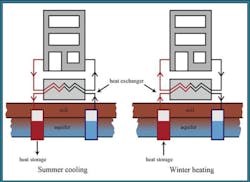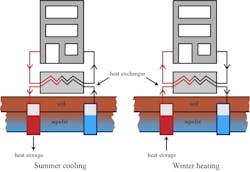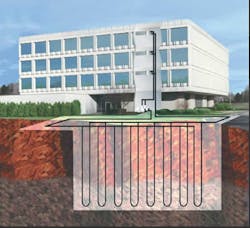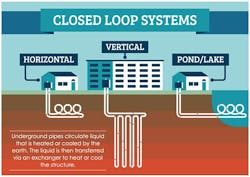How Geothermal Heating and Cooling Can Improve Building Efficiency
By MICHAEL TOBIAS, PE, LEED AP, CEM
Principal, New York Engineers, New York NY
Geothermal heating and cooling systems have a significant potential to reduce the energy footprint and environmental impact of buildings. In addition to offering the highest efficiency among the HVAC options commercially available, geothermal systems eliminate on-site fossil fuel combustion. If the local electricity grid transitions to renewable sources, emissions from power generation are eliminated as well.
When discussing geothermal heating and cooling with clients, it is important to point out the difference with geothermal power generation, a completely different concept. In the context of building projects, the term “geothermal” is associated with ground-source heat pumps (GSHP). A GSHP is efficient and reliable all year long, since underground temperatures are much more stable than outdoor temperatures.
Ground-source heat pumps can make HVAC installations more compact, since they consolidate heating and cooling into a single piece of equipment. A central GSHP can be connected with smaller water-source heat pumps serving each building area, through a hydronic piping loop.
This setup allows simultaneous heating and cooling of different building areas with maximum efficiency.
Heat can be exchanged between cooled and heated areas, and the central heat pump only provides the balance.
The conventional approach for simultaneous heating and cooling is much more bulky, requiring a chiller and a boiler with separate hydronic piping. In addition, this configuration cannot exchange heat between cooled and warmed areas, reducing overall efficiency. On the other hand, a geothermal heat pump consolidates both HVAC systems and their hydronic installations.
When Is a Ground-Source Heat Pump Viable?
The main challenge associated with a geothermal installation is burying the piping loop that exchanges heat between the building and the ground. The optimal configuration for a GSHP varies depending on site conditions:
If the property has access to a body of water, a ground-source heat pump can use a submerged piping loop. This minimizes the need for excavations, reducing the total cost of the project.
When only land is available, the optimal system configuration depends on the available area. Properties with a large extension of land can use a horizontal loop, which is only buried a few feet underground.
On the other hand, properties with reduced area must use a vertical piping loop to deploy geothermal heating and cooling. Since the excavation extends several hundred feet underground, this type of installation is the most expensive.
A vertical loop is normally the only option for high-rise constructions in urban locations, where the land available is very limited. The complexity of a geothermal installation is increased in existing buildings, since excavations become more difficult and risky. The feasibility of a geothermal HVAC system is also influenced by underground conditions; for example, the presence of bedrock may limit excavations.
Geothermal systems can also be classified into closed-loop and open-loop installations:
A closed-loop system circulates water through buried or submerged pipes, but water from the system is never mixed with groundwater. A closed-loop GSHP installation is viable even when there is no groundwater, since the water loop can exchange heat with the ground itself.
On the other hand, an open-loop system circulates groundwater directly through the heat pump, and then discharges it back underground. When a geothermal HVAC system uses an open-loop configuration, a groundwater discharge permit is required.
An open-loop system has a lower cost because it only needs two wells for supply and discharge, while a closed-loop system requires more piping length. However, open-loop systems can only be deployed when groundwater conditions are adequate.
The operating cost of a geothermal system in heating mode is comparable to that of a high-efficiency boiler. The geothermal system may have a slightly higher running cost in places with expensive electricity, while the boiler is more expensive to run if natural gas has a high price. However, a geothermal heating system can operate with zero emissions if the electricity source is clean, while a gas boiler has no way to eliminate emissions.
Comparing Geothermal Heat Pumps with Air-Source Heat Pumps
Air-source heat pumps (ASHP) are a simpler and more affordable HVAC option, exchanging heat with outdoor air like conventional air conditioners.
Since there are no excavations involved, installing an ASHP is simpler and less expensive than installing a GSHP.
However, while an air-source heat pump yields savings in the range of 40 to 60 percent compared with a resistance heater, a geothermal installation can achieve savings of over 75 percent.
Air-source heat pumps may be unable to deliver enough heating on the coldest days of winter, since ice and snow build up on their outdoor units. On the other hand, ground-source heat pumps do not have this issue thanks to the stable underground temperature. Although an ASHP can melt ice on the outdoor unit with a defrost cycle, it cannot deliver space heating while the cycle lasts. Low outdoor temperatures increase the frequency of defrost cycles, reducing the effective heating output of an ASHP.
While air-source heat pumps do not have the efficiency of a geothermal system, there are many promising applications for them. For instance, they are the second-best option if site conditions limit the installation of a geothermal heat pump. They are also a viable and cost-effective option if the client’s budget cannot cover a geothermal installation.
How Geothermal HVAC Could Drive Changes in the Power Sector
Space heating and hot water systems represent a large share of building emissions, since most of these installations still rely on fossil fuel combustion. Traditionally, the alternative has been electric resistance heating, but its operating cost is prohibitive unless a building owner has access to very low electricity rates.
Geothermal heat pumps have emerged as a viable solution to decarbonize heating and cooling systems, since they can match the cost of combustion heating without the local emissions. It is important to note that the use of heat pumps does not eliminate emissions completely if the local power grid still depends on fossil fuels, but it is a first step. If building heating systems are electrified, they automatically become emissions-free as the local grid is decarbonized.
How to Enhance Geothermal Heating and Cooling Performance
An efficient HVAC technology reduces energy costs in buildings, but there are complementary measures that enhance performance. If the building is well-insulated and airtight, it minimizes unwanted heat movement — into the building during summer, and out of the building during winter. Also, hydronic pumps and air-handling units can be equipped with high-efficiency motors and speed controls, to modulate their output according to HVAC needs.
Solar photovoltaic systems can achieve synergy with geothermal heat pumps, since any surplus generation can be used for heating and cooling. This is not possible with combustion heaters, since they have no way to interact with a solar power system. A ground-source heat pump with a hot water tank can act as a very efficient energy storage system, since each kilowatt-hour of solar generation can be converted into around 4 kWh of stored heat.
A mechanical engineer based in Manhattan, the author founded New York Engineers in 2004. Today, he leads a team of 30+ mechanical, electrical, plumbing and fire protection engineers with experience on over 1,000 projects in seven U.S. states, as well as Singapore and Malaysia.





